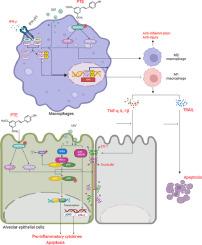当前位置:
X-MOL 学术
›
Phytomedicine
›
论文详情
Our official English website, www.x-mol.net, welcomes your feedback! (Note: you will need to create a separate account there.)
Insights into the mechanism of action of pterostilbene against influenza A virus-induced acute lung injury
Phytomedicine ( IF 6.7 ) Pub Date : 2024-03-24 , DOI: 10.1016/j.phymed.2024.155534 Yuehan Zhang , Jiashun Li , Zhenhua Qiu , Linyan Huang , Sushan Yang , Jinfeng Li , Kunlang Li , Yueyun Liang , Xuanyu Liu , Zecheng Chen , Jing Li , Beixian Zhou
Phytomedicine ( IF 6.7 ) Pub Date : 2024-03-24 , DOI: 10.1016/j.phymed.2024.155534 Yuehan Zhang , Jiashun Li , Zhenhua Qiu , Linyan Huang , Sushan Yang , Jinfeng Li , Kunlang Li , Yueyun Liang , Xuanyu Liu , Zecheng Chen , Jing Li , Beixian Zhou

|
Severe respiratory system illness caused by influenza A virus infection is associated with excessive inflammation and abnormal apoptosis in alveolar epithelial cells (AEC). However, there are limited therapeutic options for influenza-associated lung inflammation and apoptosis. Pterostilbene (PTE, trans-3,5-dimethoxy-4-hydroxystilbene) is a dimethylated analog of resveratrol that has been reported to limit influenza A virus infection by promoting antiviral innate immunity, but has not been studied for its protective effects on virus-associated inflammation and injury in AEC. Our study aimed to investigate the protective effects and underlying mechanisms of PTE in modulating inflammation and apoptosis in AEC, as well as its effects on macrophage polarization during influenza virus infection. A murine model of influenza A virus-mediated acute lung injury was established by intranasal inoculation with 5LD of mouse-adapted H1N1 viruses. Hematoxylin and eosin staining, immunofluorescence, 3-(4,5-dimethylthiazol-2-yl)-2,5-diphenyltetrazolium bromide (MTT) assay, western blotting, Luminex and flow cytometry were performed. PTE effectively mitigated lung histopathological changes and injury induced by H1N1 viruses . These beneficial effects of PTE were attributed to the suppression of inflammation and apoptosis in AEC, as well as the modulation of M1 macrophage polarization. Mechanistic investigations revealed that PTE activated the phosphorylated AMP-activated protein kinase alpha (P-AMPKα)/sirtui1 (Sirt1)/PPARγ coactivator 1-alpha (PGC1α) signal axis, leading to the inhibition of nuclear factor kappa-B (NF-κB) and p38 mitogen-activated protein kinase (MAPK) signaling induced by H1N1 viruses, thereby attenuating inflammation and apoptosis in AEC. PTE also forced activation of the P-AMPKα/Sirt1/PGC1α signal axis in RAW264.7 cells, counteracting the activation of phosphorylated signal transducer and activator of transcription 1 (P-STAT1) induced by H1N1 viruses and the augment of P-STAT1 activation in RAW264.7 cells with interferon-gamma (IFN-γ) pretreatment before viral infection, thereby reducing H1N1 virus-mediated M1 macrophage polarization as well as the enhancement of macrophages into M1 phenotypes elicited by IFN-γ pretreatment. Additionally, the promotion of the transition of macrophages towards the M2 phenotype by PTE was also related to activation of the P-AMPKα/Sirt1/PGC1α signal axis. Moreover, co-culturing non-infected AEC with H1N1 virus-infected RAW264.7 cells in the presence of PTE inhibited apoptosis and tight junction disruption, which was attributed to the suppression of pro-inflammatory mediators and pro-apoptotic factors in an AMPKα-dependent manner. In conclusion, our findings suggest that PTE may serve as a promising novel therapeutic option for treating influenza-associated lung injury. Its ability to suppress inflammation and apoptosis in AEC, modulate macrophage polarization, and preserve alveolar epithelial cell integrity highlights its potential as a therapeutic agent in influenza diseases.
中文翻译:

紫檀芪抗甲型流感病毒急性肺损伤作用机制的探讨
甲型流感病毒感染引起的严重呼吸系统疾病与肺泡上皮细胞(AEC)过度炎症和异常凋亡有关。然而,流感相关肺部炎症和细胞凋亡的治疗选择有限。紫檀芪(PTE,反式-3,5-二甲氧基-4-羟基芪)是白藜芦醇的二甲基化类似物,据报道可通过促进抗病毒先天免疫来限制甲型流感病毒感染,但尚未研究其对病毒的保护作用。 AEC 中相关的炎症和损伤。我们的研究旨在探讨 PTE 在调节 AEC 炎症和细胞凋亡中的保护作用和潜在机制,以及在流感病毒感染期间对巨噬细胞极化的影响。通过鼻内接种5LD的小鼠适应H1N1病毒建立甲型流感病毒介导的急性肺损伤的小鼠模型。进行苏木精和伊红染色、免疫荧光、3-(4,5-二甲基噻唑-2-基)-2,5-二苯基溴化四唑(MTT)测定、蛋白质印迹、Luminex和流式细胞术。 PTE有效减轻H1N1病毒引起的肺组织病理学变化和损伤。 PTE 的这些有益作用归因于抑制 AEC 中的炎症和细胞凋亡,以及调节 M1 巨噬细胞极化。机制研究表明,PTE 激活磷酸化 AMP 激活蛋白激酶 α (P-AMPKα)/sirtui1 (Sirt1)/PPARγ 共激活剂 1-α (PGC1α) 信号轴,从而抑制核因子 kappa-B (NF-κB) )和 H1N1 病毒诱导的 p38 丝裂原激活蛋白激酶 (MAPK) 信号传导,从而减轻 AEC 中的炎症和细胞凋亡。 PTE 还强制激活 RAW264.7 细胞中的 P-AMPKα/Sirt1/PGC1α 信号轴,抵消 H1N1 病毒诱导的磷酸化信号转导器和转录激活剂 1 (P-STAT1) 的激活以及 P-STAT1 激活的增强在病毒感染前用干扰素-γ (IFN-γ) 预处理 RAW264.7 细胞,从而减少 H1N1 病毒介导的 M1 巨噬细胞极化以及 IFN-γ 预处理引起的巨噬细胞向 M1 表型的增强。此外,PTE促进巨噬细胞向M2表型转变也与P-AMPKα/Sirt1/PGC1α信号轴的激活有关。此外,在 PTE 存在的情况下,将未感染的 AEC 与 H1N1 病毒感染的 RAW264.7 细胞共培养可抑制细胞凋亡和紧密连接破坏,这归因于 AMPKα- 中促炎介质和促凋亡因子的抑制。依赖方式。总之,我们的研究结果表明,PTE 可能作为治疗流感相关肺损伤的一种有前景的新型治疗选择。它抑制 AEC 中的炎症和细胞凋亡、调节巨噬细胞极化和保持肺泡上皮细胞完整性的能力凸显了其作为流感疾病治疗剂的潜力。
更新日期:2024-03-24
中文翻译:

紫檀芪抗甲型流感病毒急性肺损伤作用机制的探讨
甲型流感病毒感染引起的严重呼吸系统疾病与肺泡上皮细胞(AEC)过度炎症和异常凋亡有关。然而,流感相关肺部炎症和细胞凋亡的治疗选择有限。紫檀芪(PTE,反式-3,5-二甲氧基-4-羟基芪)是白藜芦醇的二甲基化类似物,据报道可通过促进抗病毒先天免疫来限制甲型流感病毒感染,但尚未研究其对病毒的保护作用。 AEC 中相关的炎症和损伤。我们的研究旨在探讨 PTE 在调节 AEC 炎症和细胞凋亡中的保护作用和潜在机制,以及在流感病毒感染期间对巨噬细胞极化的影响。通过鼻内接种5LD的小鼠适应H1N1病毒建立甲型流感病毒介导的急性肺损伤的小鼠模型。进行苏木精和伊红染色、免疫荧光、3-(4,5-二甲基噻唑-2-基)-2,5-二苯基溴化四唑(MTT)测定、蛋白质印迹、Luminex和流式细胞术。 PTE有效减轻H1N1病毒引起的肺组织病理学变化和损伤。 PTE 的这些有益作用归因于抑制 AEC 中的炎症和细胞凋亡,以及调节 M1 巨噬细胞极化。机制研究表明,PTE 激活磷酸化 AMP 激活蛋白激酶 α (P-AMPKα)/sirtui1 (Sirt1)/PPARγ 共激活剂 1-α (PGC1α) 信号轴,从而抑制核因子 kappa-B (NF-κB) )和 H1N1 病毒诱导的 p38 丝裂原激活蛋白激酶 (MAPK) 信号传导,从而减轻 AEC 中的炎症和细胞凋亡。 PTE 还强制激活 RAW264.7 细胞中的 P-AMPKα/Sirt1/PGC1α 信号轴,抵消 H1N1 病毒诱导的磷酸化信号转导器和转录激活剂 1 (P-STAT1) 的激活以及 P-STAT1 激活的增强在病毒感染前用干扰素-γ (IFN-γ) 预处理 RAW264.7 细胞,从而减少 H1N1 病毒介导的 M1 巨噬细胞极化以及 IFN-γ 预处理引起的巨噬细胞向 M1 表型的增强。此外,PTE促进巨噬细胞向M2表型转变也与P-AMPKα/Sirt1/PGC1α信号轴的激活有关。此外,在 PTE 存在的情况下,将未感染的 AEC 与 H1N1 病毒感染的 RAW264.7 细胞共培养可抑制细胞凋亡和紧密连接破坏,这归因于 AMPKα- 中促炎介质和促凋亡因子的抑制。依赖方式。总之,我们的研究结果表明,PTE 可能作为治疗流感相关肺损伤的一种有前景的新型治疗选择。它抑制 AEC 中的炎症和细胞凋亡、调节巨噬细胞极化和保持肺泡上皮细胞完整性的能力凸显了其作为流感疾病治疗剂的潜力。












































 京公网安备 11010802027423号
京公网安备 11010802027423号